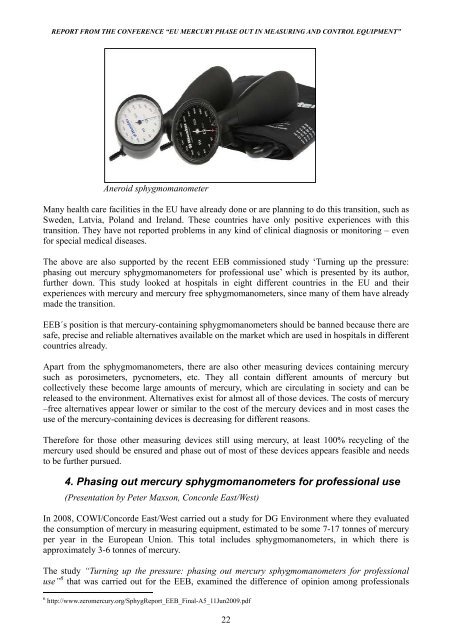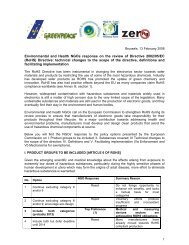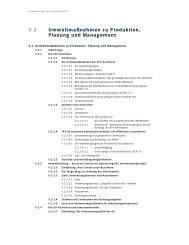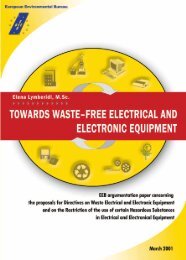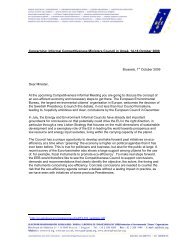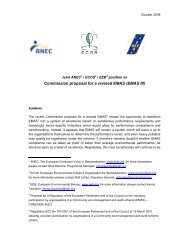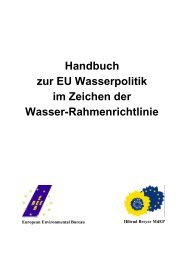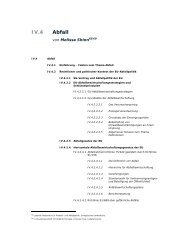REPORT FROM THE CONFERENCE “EU MERCURY PHASE OUT IN MEASURING AND CONTROL EQUIPMENT”• COCIR/Philips expla<strong>in</strong>ed that there is no question that we have some other techniques thatmeasure pressure more accurately than with a column of mercury. However, such techniquesshould be correlated somehow to human health; <strong>and</strong> for that there is a need for real validationdata <strong>and</strong> potentially some longitud<strong>in</strong>al data to make sense of it. At the very least you wouldneed a wide range of cl<strong>in</strong>ical studies compar<strong>in</strong>g the traditional auscultation <strong>and</strong> a mov<strong>in</strong>gcolumn – which could be done on a double-headed system us<strong>in</strong>g the same cuff pull<strong>in</strong>g thoseerrors <strong>out</strong>. Nonetheless, COCIR/Philips commented that today we do not have a fully validated,similarly accurate or better mercury-free alternative.3. NGOs view <strong>and</strong> experiences on mercury-free measur<strong>in</strong>g devices(Presentation by Dr. Anna L<strong>in</strong>d, <strong>Eu</strong>ropean Environmental Bureau)<strong>Mercury</strong> is highly toxic <strong>and</strong> exposure to it causes risk to human health <strong>and</strong> the environment. That iswhy the aim of the EU mercury strategy is to reduce mercury levels <strong>in</strong> the environment by reduc<strong>in</strong>gmercury use, supply <strong>and</strong> emissions. This is <strong>in</strong> l<strong>in</strong>e with what was discussed on the 25 th UNEPGovern<strong>in</strong>g Council meet<strong>in</strong>g where governments agreed that there is a need for a global legallyb<strong>in</strong>d<strong>in</strong>g <strong>in</strong>strument to tackle the mercury problem.<strong>Mercury</strong> sphygmomanometers conta<strong>in</strong> a large amount of mercury (ab<strong>out</strong> 80g - 100g) <strong>and</strong> are widelyused <strong>in</strong> hospitals <strong>and</strong> practitioners’ offices <strong>in</strong> the EU. The negative effects when us<strong>in</strong>g mercurysphygmomanometers emerge when these are broken, if they are dropped or if there is leakage. Thiscauses risk to staff <strong>and</strong> patients <strong>in</strong> the hospitals. The toxic mercury vapour can be <strong>in</strong>haled bybyst<strong>and</strong>ers (patients, doctors, nurses <strong>and</strong> other hospital staff) <strong>and</strong> rema<strong>in</strong> <strong>in</strong> the sett<strong>in</strong>g for a longtime (<strong>in</strong> the carpet or <strong>in</strong> furniture or <strong>in</strong> floor cracks) if not taken care properly. Women ofchildbear<strong>in</strong>g age, pregnant women <strong>and</strong> children are most susceptible. It is also a risk to theenvironment when mercury sphygmomanometers enter the waste stream, either when l<strong>and</strong> filled or<strong>in</strong>c<strong>in</strong>erated. The positive effect of us<strong>in</strong>g mercury-free sphygmomanometers is, consequently, thereduced mercury burden <strong>in</strong> the society.Furthermore negative cost effects are related with mercury conta<strong>in</strong><strong>in</strong>g sphygmomanometersespecially <strong>in</strong> the event of breakage, leakage, spillage, consider<strong>in</strong>g that those are hazardous waste.Such costs (<strong>and</strong> staff time) are associated with the need for: special <strong>in</strong>frastructure/storage to dealwith hazardous waste, clos<strong>in</strong>g down a room, special clean up procedure, cost to tra<strong>in</strong> staff <strong>in</strong>hazardous waste management as well as costs related to health care costs for treatment of hospitalstaff or patients for exposure to mercury.On the other h<strong>and</strong>, there are suitable mercury free devices already available on the market. They aresold from many medical equipment suppliers, are validated <strong>and</strong> satisfy the criteria of theprofessional medical organisations such as the British Hypertension Society <strong>and</strong> the <strong>Eu</strong>ropeanSociety for Hypertension. They have been proven to have no problems <strong>in</strong> any k<strong>in</strong>d of cl<strong>in</strong>icaldiagnosis or monitor<strong>in</strong>g – even for special medical conditions such as arrhythmia, pre-eclampsia,diabetes or hypertension <strong>and</strong> other vascular diseases. Such mercury-free products are available fromWelch Allyn, Microlife, SunTech Medical, American Diagnosis Corporation Triml<strong>in</strong>e MedicalProducts, Omrori, Rudolf Riester, He<strong>in</strong>e Optotechnik, BOSCH + SOHN, Braun, Terumo, Se<strong>in</strong>ex.21
REPORT FROM THE CONFERENCE “EU MERCURY PHASE OUT IN MEASURING AND CONTROL EQUIPMENT”Aneroid sphygmomanometerMany health care facilities <strong>in</strong> the EU have already done or are plann<strong>in</strong>g to do this transition, such asSweden, Latvia, Pol<strong>and</strong> <strong>and</strong> Irel<strong>and</strong>. These countries have only positive experiences with thistransition. They have not reported problems <strong>in</strong> any k<strong>in</strong>d of cl<strong>in</strong>ical diagnosis or monitor<strong>in</strong>g – evenfor special medical diseases.The above are also supported by the recent <strong>EEB</strong> commissioned study ‘Turn<strong>in</strong>g up the pressure:phas<strong>in</strong>g <strong>out</strong> mercury sphygmomanometers for professional use’ which is presented by its author,further down. This study looked at hospitals <strong>in</strong> eight different countries <strong>in</strong> the EU <strong>and</strong> theirexperiences with mercury <strong>and</strong> mercury free sphygmomanometers, s<strong>in</strong>ce many of them have alreadymade the transition.<strong>EEB</strong>´s position is that mercury-conta<strong>in</strong><strong>in</strong>g sphygmomanometers should be banned because there aresafe, precise <strong>and</strong> reliable alternatives available on the market which are used <strong>in</strong> hospitals <strong>in</strong> differentcountries already.Apart from the sphygmomanometers, there are also other measur<strong>in</strong>g devices conta<strong>in</strong><strong>in</strong>g mercurysuch as porosimeters, pycnometers, etc. They all conta<strong>in</strong> different amounts of mercury butcollectively these become large amounts of mercury, which are circulat<strong>in</strong>g <strong>in</strong> society <strong>and</strong> can bereleased to the environment. Alternatives exist for almost all of those devices. The costs of mercury–free alternatives appear lower or similar to the cost of the mercury devices <strong>and</strong> <strong>in</strong> most cases theuse of the mercury-conta<strong>in</strong><strong>in</strong>g devices is decreas<strong>in</strong>g for different reasons.Therefore for those other measur<strong>in</strong>g devices still us<strong>in</strong>g mercury, at least 100% recycl<strong>in</strong>g of themercury used should be ensured <strong>and</strong> <strong>phase</strong> <strong>out</strong> of most of these devices appears feasible <strong>and</strong> needsto be further pursued.4. Phas<strong>in</strong>g <strong>out</strong> mercury sphygmomanometers for professional use(Presentation by Peter Maxson, Concorde East/West)In 2008, COWI/Concorde East/West carried <strong>out</strong> a study for DG Environment where they evaluatedthe consumption of mercury <strong>in</strong> measur<strong>in</strong>g equipment, estimated to be some 7-17 tonnes of mercuryper year <strong>in</strong> the <strong>Eu</strong>ropean Union. This total <strong>in</strong>cludes sphygmomanometers, <strong>in</strong> which there isapproximately 3-6 tonnes of mercury.The study “Turn<strong>in</strong>g up the pressure: phas<strong>in</strong>g <strong>out</strong> mercury sphygmomanometers for professionaluse” 6 that was carried <strong>out</strong> for the <strong>EEB</strong>, exam<strong>in</strong>ed the difference of op<strong>in</strong>ion among professionals6 http://www.zeromercury.org/SphygReport_<strong>EEB</strong>_F<strong>in</strong>al-A5_11Jun2009.pdf22


